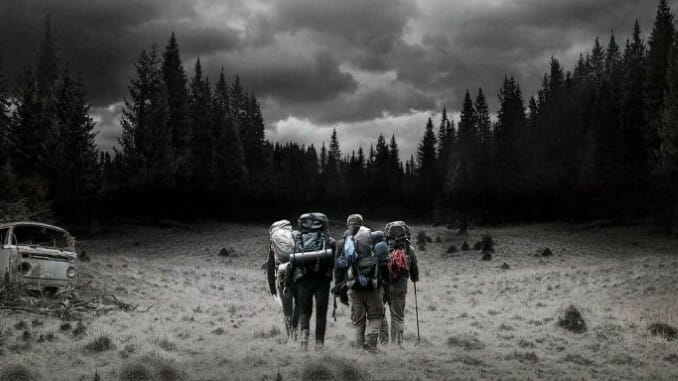
When it comes to horror film settings, there’s no locale more primal or elemental than the lonely vastness of the great outdoors. The seemingly empty expanses outside of civilization have been a staple of horror fiction for as long as humanity has had any conception of “horror” or fiction itself—from the time mankind settled in the first villages, there were always presumably stories of the dangers and terrors that lurked in remote places, far from help or rescue. It’s a fear that is hardwired into our very DNA. This wilderness horror is also the setting of a lot of subpar, golden-era slashers such as the aptly titled Don’t Go in the Woods.
What is it that still frightens us about those places, even now in the 21st century? Perhaps it’s the tacit admission that by journeying into the wilderness, we’re giving up any semblance of the protective blanket that civilization offers us. Beyond the fact that there are no police, no hospitals, and not a Denny’s to be found, there’s also no guarantee of what one might call “the social contract.” We fear those people who journey to these places or choose to dwell in them, because we fear what a person might do if they live a life with no need for “society.” Conversely, we both fear the thought of those expanses being empty, as that would leave us stranded with nothing but ourselves, and we fear them not being empty, populated by monsters or beasts unknown to science.
But when it comes to wilderness horror movies, one does sort of have to answer the question of what qualifies as “wilderness.” Most entries in the Friday the 13th series take place at a summer camp, after all, which is technically in a wooded setting, but does that actually feel like anyone’s conception of the wild? We’re not talking about the well-structured, child-packed summer camps seen in the likes of Friday the 13th or Sleepaway Camp, or the “vacation homes” of Tucker & Dale vs. Evil or The Cabin in the Woods. You need to at least get to the truly remote feeling of say, Evil Dead before the word “wilderness” starts to feel appropriate. The films on this list are a tribute to the feeling of walking entirely off the edge of the map, where no one will ever find you.
Here are 20 of our favorite wilderness horror movies, presented in alphabetical order.
AnacondaYear: 1997
Director: Luis Llosa
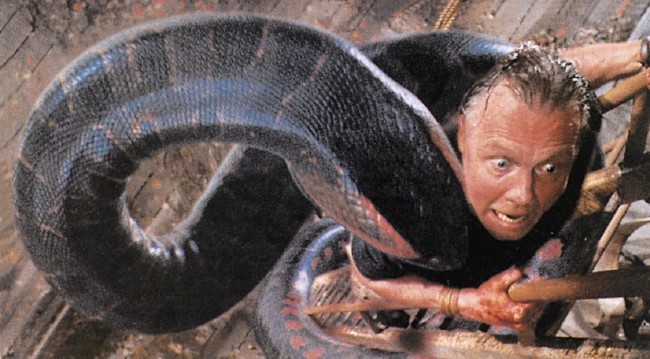
Jennifer Lopez, Ice Cube, Jon Voight … creature features don’t get more “late 1990s” than Anaconda, do they? A sweaty expedition into the heart of the Amazon, the film from Peruvian director Luis Llosa feels a bit like one of the last of its kind—pulpy, FX-driven creature features with big budgets, in wide release. This thing had a budget of $45 million, folks! Nothing to sneeze at, especially in 1997—that’s a bigger budget than It had in 2017, in fact. That money ends up right on the screen in the form of some pretty damn good makeup and animatronic FX, although waxy CGI definitely makes some appearances as well. There’s no subtlety of any kind to be seen here, just pure serpent spectacle, which makes Anaconda a cheesy joy in its own way. How can you genuinely hate a film that involves Jon Voight being swallowed alive by a giant snake, and then regurgitated minutes later, covered in a thick sheen of anaconda saliva? The allure of seeing that depicted on screen speaks for itself. —Jim Vorel
BackcountryYear: 2014
Director: Adam MacDonald

Much was made of the brutality and naturalism of the bear attack sequence in Alejandro Iñárritu’s The Revenant in 2015, but a year earlier, little-seen Canadian wilderness horror Backcountry delivered an even more gore-streaked recreation of a similar incident, this time involving two people instead of one. Backcountry is the story of Alex (Jeff Roop) and Jen (Missy Peregrym), two lovers who run afoul of their own hubris when they head into a national park forest with more unearned confidence than sense, and then run afoul of a particularly tenacious black bear. Unrepentant in its brutality and realism, Backcountry chronicles both the ill-advised trek out into the wilderness, and the incredibly painful fight to crawl back to the safety of civilization. Featuring smart subversions of an expected Deliverance or Straw Dogs-type plot, Backcountry instead becomes a film about a relationship weathering an impossible trial, punctuated by incredibly bloody and disturbingly realistic scenes of injury and suffering. This one isn’t a casual, entertaining weeknight watch, but it does illustrate the raw power of the wilderness. —Jim Vorel
The Blair Witch ProjectYear: 1999
Director: Eduardo Sanchez, Daniel Myrick
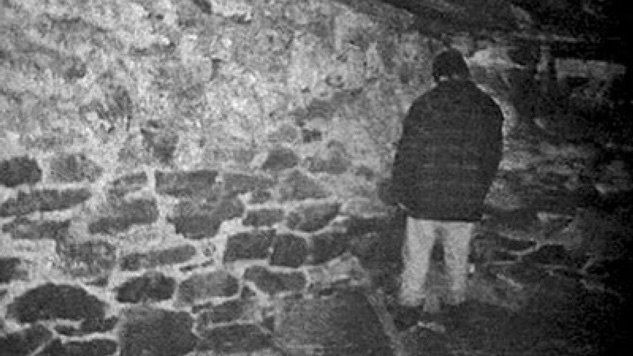
Where Scream reinvented a genre by pulling the shades back to reveal the inner workings of horror, The Blair Witch Project went the opposite route by crafting a new style of presentation and especially promotion. Sure, people had already been doing found footage movies; just look at The Last Broadcast a year earlier. But this was the first to get a wide, theatrical release, and distributor Artisan Entertainment masterfully capitalized on the lack of information available on the film to execute a mysterious online advertising campaign in the blossoming days of the Internet age. Otherwise reasonable human beings seriously went into The Blair Witch Project believing that what they were seeing might be real, and the grainy, home movie aesthetic captured an innate terror of reality and “real people” that had not been seen in the horror genre before. It was also proof positive that a well-executed micro-budget indie film could become a massive box office success. So in that sense, The Blair Witch Project reinvented two different genres at the same time. —Jim Vorel
Bone TomahawkYear: 2015
Director: S. Craig Zahler

The aesthetic of the gritty, bone-crunching horror western remains alive and well in the world of modern indie horror, and Bone Tomahawk is likely its totem. Benefitting from an unusually strong cast beyond headliners Kurt Russell, Patrick Wilson and Matthew Fox, Bone Tomahawk can boast supportive turns from the likes of Richard Jenkins, Sid Haig and Fred Melamed, giving it an unusual degree of gravity for a film that eventually delves into some of the grossest sequences of dismemberment committed to the screen in the last few decades. Playing out like an 1890s spin on The Hills Have Eyes, the film pits lawman Russell and his posse against a tribe of feral, cannibalistic natives, shunned even by their fellow native tribes and referred to as “Troglodytes.” Unrelentingly savage, its antagonists are particularly memorable examples of the human depravity so often associated with wilderness horror. —Jim Vorel
The DescentYear: 2005
Director: Neil Marshall

True camaraderie or complex relationships between female characters isn’t so much “rare” in horror cinema as it is functionally nonexistent, which is one of the things that still makes The Descent, nominally about a bunch of women fighting monsters in a cave, stand out so sharply all these years later. But ah, how The Descent transcends its one-sentence synopsis. The film’s first half is deliberately crafted to fill in the personalities of its group of women, while slowly and almost imperceptibly ratcheting up the sense of dread and foreboding. As the characters descend deeper into the cave, passageways get tighter and the audience can feel the claustrophobia and dankness creeping into their bones—and that’s before we even see any of the resident troglodytes. Neil Marshall’s screenplay makes masterful use of dubious morality, infusing its protagonists, particularly the duo of Sarah (Shauna Macdonald) and Juno (Natalie Mendoza), with numerous shades of gray. Not content to simply paint one of the two as flawed and the other as resourceful and ultimately vindicated, he uses a series of misunderstandings to illustrate human failing on a much more profound and universal level. Ultimately, The Descent is as moving a character study as it is terrifying subterranean creature feature, with one hell of an ending to boot. —Jim Vorel
The Evil DeadYear: 1983
Director: Sam Raimi

Infamously pieced together from $350,000 and an exceptional amount of goodwill, The Evil Dead, when looking back at it, seems to have created a kind of horror unto itself. Sam Raimi’s debut, of course, is notable for so much more than that: like how it was edited by Joel Coen; or how Stephen King’s rabid interest caught the attention of a major studio, giving Raimi and close bud Bruce Campbell the chance to pour everything they knew about slashers, slapstick, camp, pulp and fantasy into Evil Dead II, a kind of sequel/reboot hybrid. But the real gauge of The Evil Dead’s tenor is perhaps best exemplified by the fact that its 2013 remake was something of a sickening feast for gore-hounds. For those familiar with Evil Dead II and the even sillier Army of Darkness, the fact that the original film was more of a straightforward genre affair feels somehow off; behold cognitive dissonance in full effect. And yet, somehow this rudimentary story of five Michigan State students who unwittingly unleash ancient demons in a cabin in the woods is still surprisingly, mercilessly skin-crawling. Leave it to Sam Raimi to stretch a dollar so far the sound of it snapping has the same effect on our stomachs as a classic bump in the night. —Dom Sinacola
The Hills Have EyesYear: 1977
Director: Wes Craven
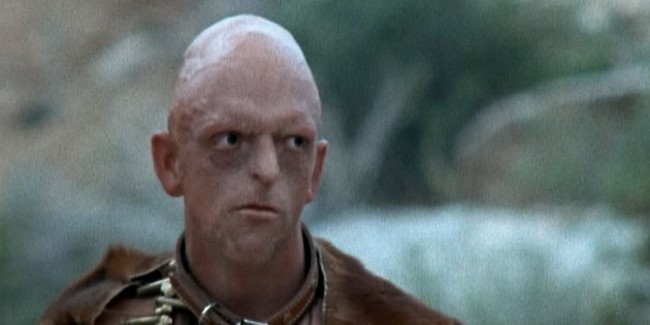
Seven years before A Nightmare on Elm Street made Wes Craven a household name, he was crafting a grindhouse classic in The Hills Have Eyes. It shares some DNA with his hard-to-watch revenge film The Last House on the Left, but it’s a far better film overall, with a tighter story. You probably know the basics: A family on vacation blunders into a stretch of the desert where they really shouldn’t be and fall victim to a band of bestial hill people, with the weathered, unnatural face of Michael Berryman front and center. It received an X-rating on first release, which isn’t too surprising—this is a movie where cannibals steal a baby so they can eat it, after all. It’s the sort of elemental good vs. evil story that we all fear, in the back of our minds, when we venture off the beaten path and realize how vulnerable we are away from the comforts of civilization. Director Alexandre Aja’s 2006 remake, meanwhile, pumps up the explicit violence and goriness of the spectacle, while leaving Craven’s social satire relatively intact. — Jim Vorel
HoneymoonYear: 2014
Director: Leigh Janiak

The cool thing about horror is that if you just have the vision, you can make something like Honeymoon with no more resources than an empty cabin and a few weeks of spare time. The film only has four actors, and two of them barely appear, leaving everything on the shoulders of the two young stars, Rose Leslie (Ygritte from Game of Thrones) and Harry Treadway. This is the right decision to make: If you’ve got a few solid, young actors, why not let the film just become a statement of their talents? The story is extremely simple, with a newlywed couple going on their honeymoon in a remote cabin in the woods. When Bea, the wife, wanders away one night and has some kind of disturbing event in the woods, she comes back changed, and it begins to affect both her memory and sense of identity. The next hour or so is a slow-burning but well-acted and suspenseful journey for the two as the husband’s suspicions grow and the warning flags continue to mount. By the end, emotions and gross-out scares are both running high. —Jim Vorel
Just Before DawnYear: 1981
Director: Jeff Lieberman
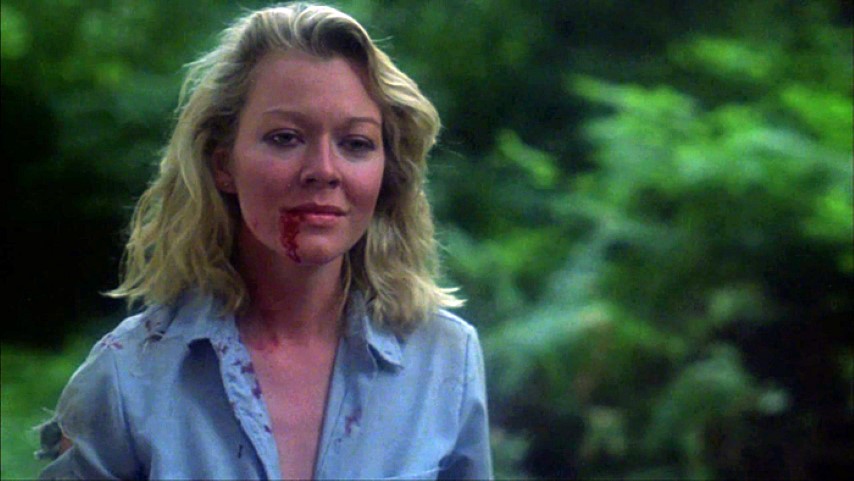
“Summer camp” horror films undeniably take place on the edges of the map, away from the lights and prying eyes of the city. But none of them really captures the mystery and terror of the wilderness like 1981’s Just Before Dawn. Where the likes of Friday the 13th take place in locales perched on the edge of well-trodden woods, where nature-curious white folks can tromp and arrogantly picture themselves as outdoorsmen or adventurers, Just Before Dawn descends into the real forest, where undocumented families live off the grid in tar paper shacks and a blood-curdling scream can trail off into the night without another soul hearing it. This is a slasher film utterly defined by its uniquely mysterious and beautiful location, a factor that elevates a run-of-the-mill story into something truly unique. As one of the characters literally says out loud: “Where we’re going is no summer camp.” The location in question: Silver Falls State Park, a slice of the Oregonian Pacific Northwest that offers up some of the more beautiful nature photography you’re ever going to see in a horror movie. Considering the low aims of this standard slasher plot, the result is almost unaccountably beautiful, thanks to locations such as huge, cascading waterfalls and rickety rope bridges. Thematically, it lends power to the idea that this group of young people must pay for the crime of disrespecting the sanctity of this place, because this place looks worthy of somehow summoning a demented killer to it. Rarely has any slasher film benefited so much from location shooting. —Jim Vorel
Open WaterYear: 2003
Director: Chris Kentis
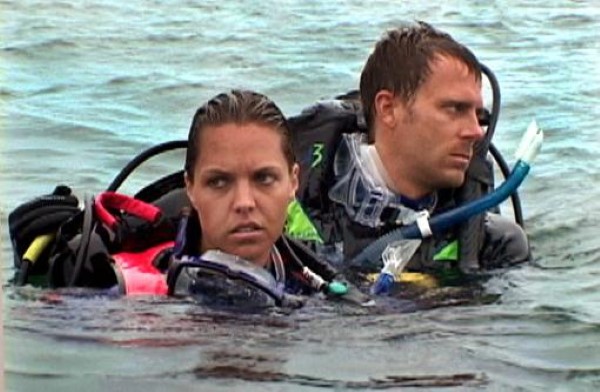
Open Water is just about the most simplistic and effective horror premise there is—you’re stranded in a place that is completely alien and inhospitable to human life, and you have no idea what to do about it. To be left behind by a scuba diving boat, as the protagonists here are, is the ultimate oceanic nightmare—not only are they now exposed to the elements, they don’t even have the faintest idea of which way they might somehow go to reach land. And that’s not even raising the spectre of the sharks, who begin circling shortly thereafter. It’s the ultimate cinematic portrayal of sheer, utter powerlessness—if the sharks decide that you’re dying today, then what are you reasonably planning on doing about it? A masked killer might be overcome. The entire ocean? Good luck with that. —Jim Vorel
RavenousYear: 1999
Director: Antonia Bird
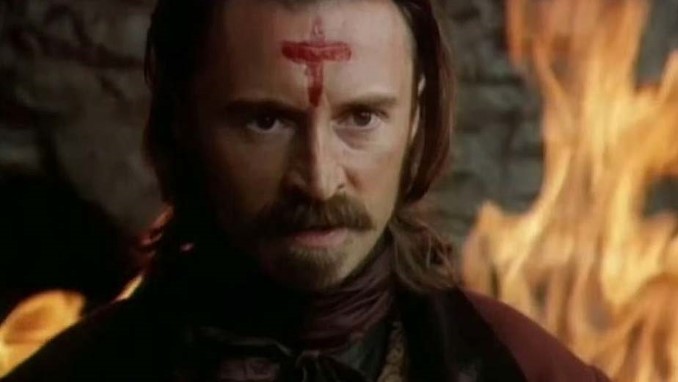
Ravenous is an odd duck of a film, and it’s no wonder that the esteem it receives from certain audiences these days is of a decidedly “cult” variety. Caught between genres, it’s a blend of serious-minded historical fiction, cannibal horror and a strong streak of black comedy, although I’d hesitate to truly refer to it as a “horror comedy” outright. The film carries itself with too much gravitas for that moniker, despite the presence of David Arquette. Guy Pearce plays a Dances With Wolves-style soldier protagonist who is haunted by the horrors of war, but there are much worse fates to come. Your true reason for watching Ravenous ought to be the wonderful Robert Carlyle, who is stupendous as a cannibalism survivor with more to him than “meats” the eye (I’m so, so sorry for that one). It all builds to a conclusion that is almost Tarantino in tone, a Resevoir Dogs standoff in which the loyalties of thieves are put to the test and Pearce’s character must decide just how badly he wants to survive. It would probably be a fun movie to watch while preparing a standing rib roast. —Jim Vorel
The RitualYear: 2017
Director: David Bruckner
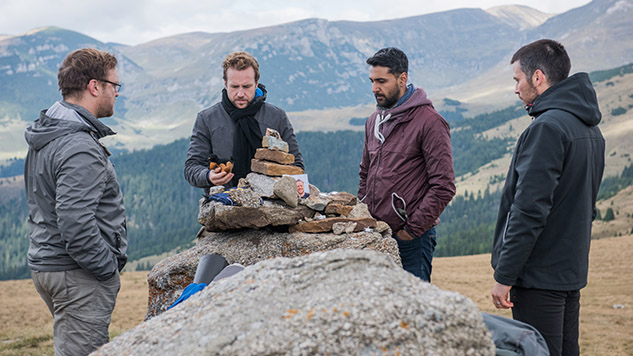
A prime example of what might be termed the “bro horror” subgenre, The Ritual’s characters are a band of lifelong mates united in mourning a friend who has recently been killed in a brutal liquor store robbery. Luke (Rafe Spall) is the member of the group who shoulders the greatest burden of guilt, being the only one who was in the store at the time, paralyzed with indecision and cowardice while he watched his friend die. The other members clearly blame Luke for this to varying degrees, and one senses that their decision to journey to Sweden for a hiking trip deep into the wilderness is less to honor their dead friend’s memory, and more to determine if their bond can ever be repaired, or whether the recrimination stemming from the death is insurmountable. Where The Ritual excels is technically, in both its imagery and sound design. Cinematographer Andrew Shulkind’s crisp images and deep focus are a welcome respite from the overly dark, muddy look of so many modern horror films with similar settings (such as Bryan Bertino’s The Monster), and the forested location shots, regardless of where they may have been filmed, are uniformly stunning. Numerous shots of tree clusters evoke Celtic knot-like imagery, these dense puzzles of foliage clearly hiding dire secrets, and we are shown just enough through the film’s first two thirds to keep the mystery palpable and engaging. Director David Bruckner, who is best known for directing well-regarded segments of horror anthologies such as V/H/S, The Signal and Southbound, demonstrates a talent here for suggestion and subtlety, aided by some excellent sound design that emphasizes every rustling leaf and creaking tree branch. Unfortunately, the characters are a bit thin for what is meant to be a character-driven film, and the big payoff can’t quite maintain the atmosphere of the film’s first two acts. Still, The Ritual is a great-looking film, and one that features one of the more memorably “WTF!” monster designs in recent memory. It’s worth a look for that alone. —Jim Vorel
The RuinsYear: 2008
Director: Carter Smith

The Ruins is a swift and vibrant tale that’s been impressively concocted from recycled material. It’s a collage of pasted pieces, but it proves once again that the flow of a dance is not always in its originality but in its grace. The plot follows four beautiful Americans—two guys and two girls—vacationing in Mexico when they decide to take a trip off the map to see a rumored archaeological dig. Blah, blah, blah. The film doesn’t waste much time explaining the unnecessary lore, but it carefully lays out the important details—the maps, the jeep, the personalities, the locations. After some efficient setup, things quickly get creepy, then gross, then both creepy and gross. Director Carter Smith alternately reconfigures his elements—torches, pulleys, out-of-control plants and backwoods emergency surgery—for a series of increasingly gruesome, weirdly creative set pieces. It’s the kind of film that Sam Raimi might have directed 20 years ago, except that Carter plays it straight, even though he seems to assume the audience won’t, offering them ample opportunities to shriek and hoot at the wounded heroes. (Screenwriter Scott B. Smith wrote Raimi’s film A Simple Plan, and cinematographer Darius Khondji has shot films by Jean-Pierre Jeunet, Michael Haneke and Wong Kar-Wai. This helps.) Just when The Ruins begins to feel too inert, too tied to its little mound, too hemmed in by an intractable problem, it leaps free of its bounds. —Robert Davis
SatorYear: 2021
Director: Jordan Graham
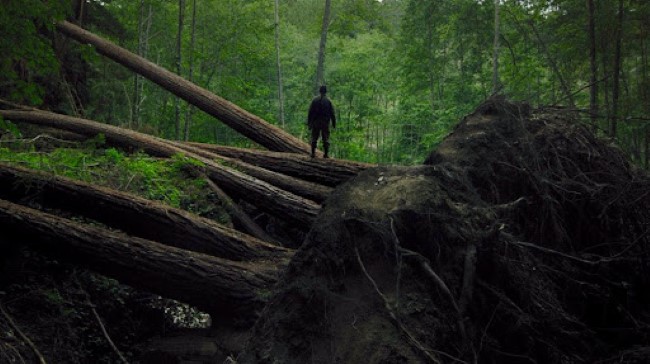
There’s something in the forest. But at the same time, there’s nothing much at all. A man, a cabin and maybe—maybe—something more. Sator, a mumblecore horror somewhere between a modern-day The Witch, The Blair Witch Project and Lovecraft, is a striking second feature from Jordan Graham. It’s the kind of horror that trades jump scares for negative space, one that opens with imagery your typical A24 beast saves for its finale. Sator’s dedication to its own nuanced premise, location and tense pace makes it the rare horror that’s so aesthetically well-realized you feel like you could crawl inside and live there—if it wasn’t so goddamn scary. Sator is a name, an evocation, an entity. He’s first described, by Nani (the late June Peterson, excellent), as a guardian. Nani’s known Sator (whatever he may be) for a long time. The film represents shifts in time, and the physical transportation to places soaked in memories, with an aspect ratio change and a black-and-white palette. Nani’s lovely longhand script is practiced well from a lifetime of automatic writing, with the words—including some of the opening company credits, which is a great little joke—pouring from her pen and claiming a headwater not of this world. That same paranormal river flows to her grandson Adam (Gabriel Nicholson), that aforementioned man in the woods, whose relationship with the voices in his head is a bit less comfortable. It’s a stark, bold, even compassionate film—which offers imperfectly planted details of a battered and bruised family at its core—with plenty to comprehend (or at least theorize about) for those brave enough to venture back into the forest for a rewatch. As scary as it is, Sator is an experience with enough layers and craftsmanship that its alluring call will rattle in your head long after you’ve turned it off.—Jacob Oller
The Texas Chain Saw MassacreYear: 1974
Director: Tobe Hooper
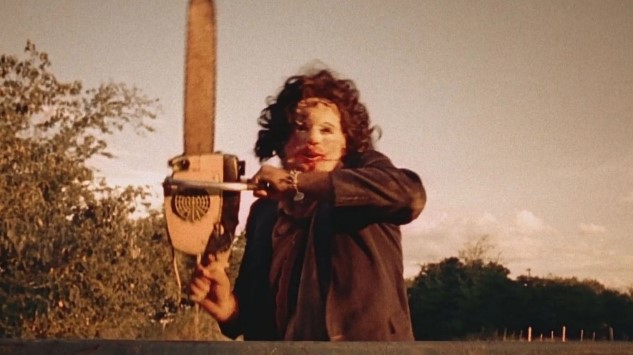
One of the most brutal mainstream horror films ever released, The Texas Chain Saw Massacre, based on notorious Wisconsin serial killer Ed Gein, resembles art-house verité built on the grainy physicality of its flat Texas setting. Plus, it introduced the superlatively sinister Leatherface, the iconic chainsaw-wielding giant of a man who wears a mask made of human skin, whose freakish sadism is upstaged only by the introduction of his cannibalistic family with whom he resides in a dilapidated house in the middle of the Texas wilderness, together chowing on the meat Leatherface and his brothers harvest, while Grandpa drinks blood and fashions furniture from victims’ bones. Still, The Texas Chain Saw Massacre might not be the goriest horror film ever made, but as an imaginal excavation of the subterranean anxieties of a post-Vietnam rural American populace, it’s pretty much unparalleled. Twisted, dark and beautiful all at once, it careens through a wide variety of tones and techniques without ever losing its singular intensity. (And there are few scenes in this era of horror with more disturbing sound design than the bit where Leatherface ambushes a guy with a single dull hammer strike to the head before slamming the metal door shut behind him.) —Rachel Haas and Brent Ables
WildernessYear: 2006
Director: M. J. Bassett
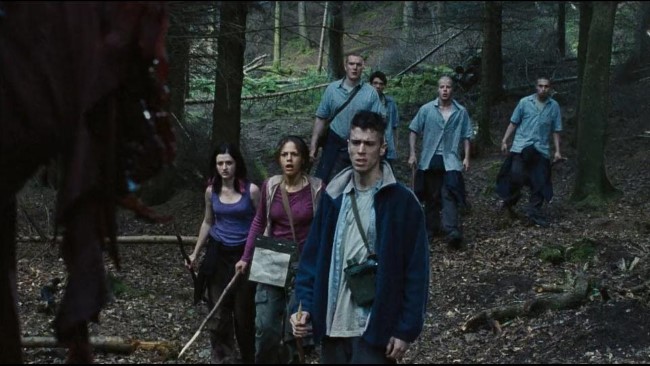
A list of wilderness horror films, which features a film literally named Wilderness? Who would have thought it could be? This indie British-Irish survival horror flick is sure to draw obvious comparisons to inspirations such as Lord of the Flies and especially Kinji Fukasaku’s Battle Royale, for the fact that it revolves around a group of juvenile delinquents in some sort of intense correctional camp, who are packed up and shipped off to a deserted island for “team building” exercises that unsurprisingly go disastrously wrong. Benefitting from surprisingly well-written interpersonal dynamics between the group members, Wilderness sees an interesting group of characters devolve into squabbling factions even before they realize they’re being stalked by an unknown killer who seems to want revenge on the entire group. Lo-fi, gritty and often quite brutal, Wilderness doesn’t shy away from dispatching its characters in particularly nasty ways (like a bear trap to the skull), which puts it in good company with something like the aforementioned Battle Royale, or even the likes of The Descent. —Jim Vorel
The WitchYear: 2015
Director: Robert Eggers
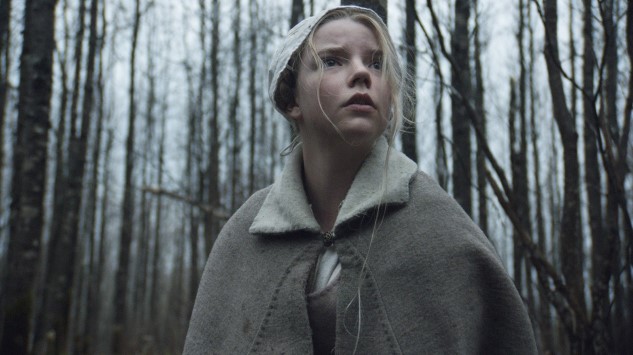
From its first moments, The Witch strands us in a hostile land. We watch (because that’s all we can do, helplessly) as puritan patriarch William (Ralph Ineson) argues stubbornly with a small council, thereby causing his family’s banishment from their “New England” community. We watch, and writer-director Robert Eggers holds our gaze while a score of strings and assorted prickly detritus—much like the dialogue-less beginning to There Will be Blood —rise to a climax that never comes. It’s a long shot, breathing dread: The wagon lurches ever-on into the wilderness, piling the frontier of this New World upon the literal frontier of an unexplored forest. It’s 1620, and William claims, “We will conquer this wilderness.” Eggers’ “New England Folk Tale” is a horror film swollen with the allure of the unknown. To say that it’s reminiscent of the Salem Witch Trials, which take place 70 years after the events in the film, would be an understatement—the inevitable consequences of such historic mania looms heavily over The Witch. All of this Eggers frames with a subconscious knack for creating tension within each shot, rarely relying on jump scares or gore, instead mounting suspense through one masterful edit after another. The effect, then, is that of a building fever dream in which primeval forces—lust, defiance, hunger, greed—simmer at the edges of experience, avoided but never quite conquered. But what’s most convincing is the burden of puritanical spirituality which blankets the film’s every single moment, a pall through which every character—especially teenage Thomasin (Anya Taylor Joy)—struggles to be, simply, a regular person. There is no joy in their worship, there is only gravitas: prayers, fasting, penitence and fear. And it’s that fear which drives the film’s horror, which eventually makes even us viewers believe that, at the fringes of civilization, at the border of the unknown, God has surely abandoned these people. —Dom Sinacola
Wolf CreekYear: 2005
Director: Greg McLean

Instantly infamous upon release, and readily lumped into the emerging group of neo-splatter films of the mid-2000s that became indelibly associated with the derogatory label of “torture porn,” Wolf Creek is a film that has seen considerable reevaluation over the years for the way it dispenses with storytelling convention and brazenly depicts events inspired by several of Australia’s most notorious crimes. Fusing a true crime aesthetic with cinematography that evokes the era of found footage without actually restricting itself by fully committing to it, Wolf Creek is the story of a group of young, urban backpackers who venture into the Australian outback, where they meet a seemingly genial man who turns out to be a prolific serial killer. Veteran Australian TV actor John Jarratt was impeccably cast as that man, Mick Taylor, a disturbingly human villain who first seems to challenge the group’s prejudices and preconceptions about the depiction of “backwards” rural dwellers, before then transforming into a living and breathing indictment of the dark, xenophobic underbelly of Australian society. His performance remains one of the most starkly terrifying depictions of a serial killer, bereft of all the aggrandizing, romanticized character traits western audiences so frequently associate with fictional masterminds. It’s a bleak, doom-wreathed film that casts aside characters who seem to fall into conventional slasher molds, shattering audience expectations as it instead attempts to accurately and hyper realistically portray the fear and harrowing psychological ordeal that would have been experienced by the victims of such a crime. Suffice to say, it remains not for the faint of heart. —Jim Vorel
Wrong TurnYear: 2003
Director: Rob Schmidt
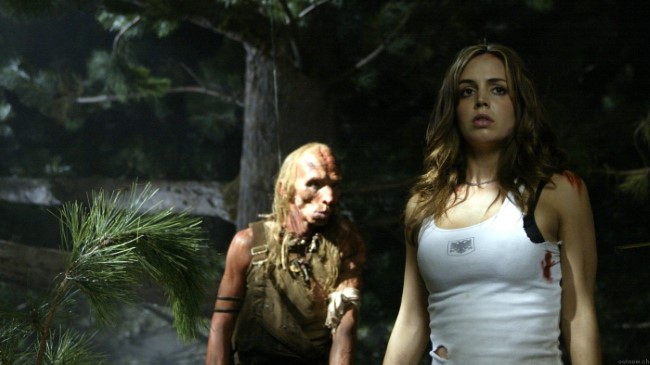
Wrong Turn is one of those cases where a pretty competent, visually interesting modern slasher film somehow spawned a series that had little if anything to do with its original installment, eventually diluting the title to the point that it becomes difficult to extricate the 2003 film from the many pieces of claptrap that followed. All films in the series concern themselves with various everyday people making “wrong turns” in the woods of West Virginia, putting them on a collision course with families of mutated, seemingly superhuman cannibals, but only the original really evokes the inevitable Texas Chain Saw Massacre or Hills Have Eyes comparisons in any substantive way. Even here in 2003, there is occasionally a somewhat silly edge to these antagonists, something highlighted by the notable decision to favor daytime shooting rather than completely obscuring the villains in darkness, which points to the effectively grotesque although sometimes humorous makeup effects. But at the same time, the original Wrong Turn is often quite effectively suspenseful, especially in sequences like the group’s initial hiding/escape from the family’s cabin, and it can boast a well-spent budget awash in top-notch gore effects that are rooted in reality. The sequels, meanwhile, ran with the ensuing popularity of the mutated cannibal villains, making them into de facto protagonists while cooking up plenty of absurdly brutal, ludicrously overcomplicated kills that result in death scenes like something out of the Final Destination series. This ultimately makes preference a matter of choice—if you favor slashers grounded in suspense and reality, watch the original Wrong Turn. If you’re instead looking for chuckle-worthy comedic ultraviolence, enjoy the ramped-up madness of Wrong Turn 2: Dead End. —Jim Vorel
YellowbrickroadYear: 2010
Director: Jesse Holland, Andy Mitton

What do you get when you cross the found footage fuzziness of The Blair Witch Project with the meta-horror musings of John Carpenter’s In the Mouth of Madness? Well, it likely would look a bit like the committedly weird creativity of 2010’s relatively unheralded Yellowbrickroad, an existential horror flick that thrives on good performances and above-average found footage cinematography, but asks its audience to let itself simply be swept away by the mysteries of the universe, logic be damned. The film is a cipher, reflecting the central mystery of its plot, which concerns a town whose residents disappeared en masse into the forest in 1940, following a screening of The Wizard of Oz. Decades later, a documentary team retraces the steps of that doomed caravan, finding their own doom along the way as the very land itself seems to leech their sanity and rewrite reality around them, not unlike the substance of say, a low-budget version of Annihilation. Yellowbrickroad is committed to this sort of high-minded artistic iconoclasm, seemingly unconcerned with whether its audience finds itself missing the more familiar beats of found footage horror. It all leads to a deeply divisive twist of an ending that falls squarely into “love it or hate it” territory, but even if horror geeks find themselves perplexed by the surprises waiting at the end of the path, they’re still likely to admire the bewitching beauty of the journey. —Jim Vorel
Jim Vorel is Paste’s resident horror guru. You can follow him on Twitter for much more film content.